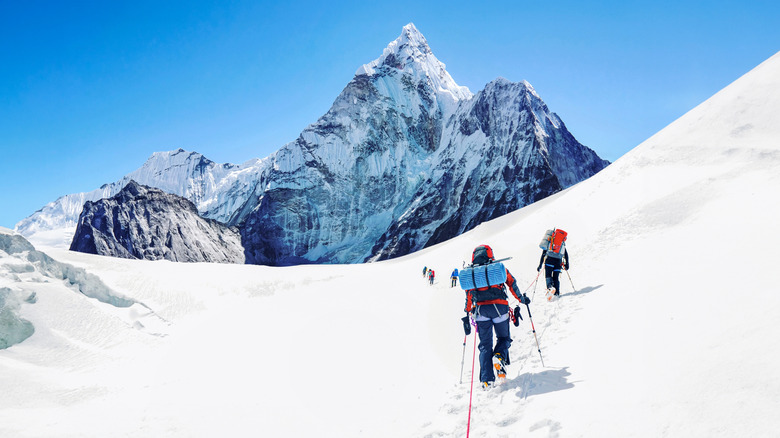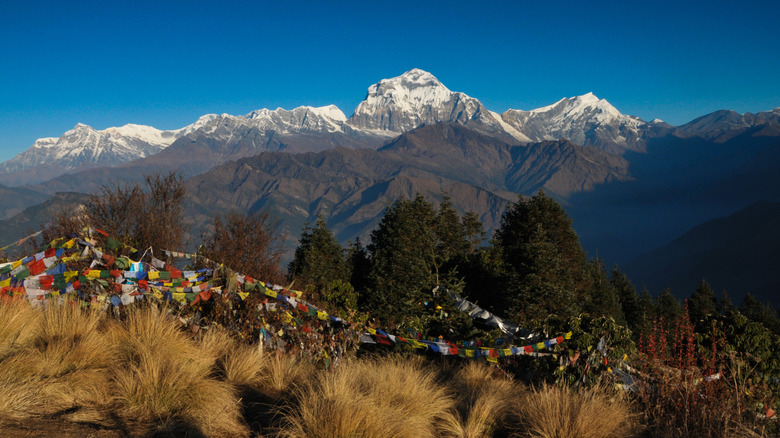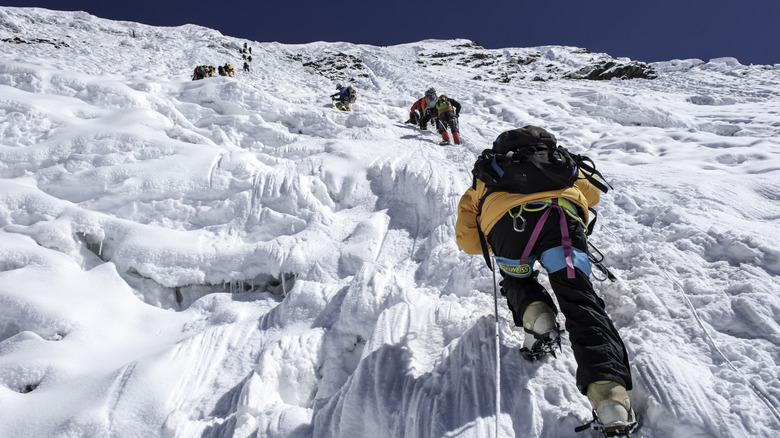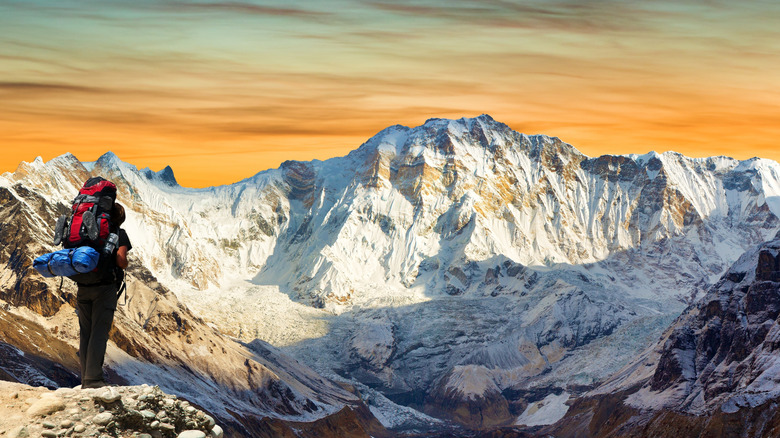Five Mountains That Are More Dangerous To Climb Than Everest
Mount Everest is the highest point on Earth. It stands at an incredible 29,032 feet and grows about 0.16 inches a year, just one of the intriguing facts about the world's tallest mountain. Summiting Mount Everest is a lifetime achievement that requires months of intensive preparation and training. Every year, hundreds of climbers attempt to scale its snowy peaks. Sadly, a few never make it back home alive — dangerously unpredictable weather is one reason Everest can turn deadly. Yet, this iconic mountain is far from being the deadliest in the world. It's not even in the top three.
Weather, geography, and infrastructure are all factors in determining how dangerous a mountain is, regardless of its size. The Himalayan Database has kept a record of all climbers who have summited mountains above 26,000 feet since the 1900s — and those who never returned. The formula for determining which mountain is most dangerous is to divide the number of summits by the number of deaths. Historically, Everest had a death rate of approximately 14%. Today, that risk has been reduced significantly to about 1% thanks to improved logistics on the mountain. Still, according to that grim calculation, there are a few other summits deadlier than Everest.
There's a reason climbers call the area above 26,000 feet the "death zone" — and no accident that all five mountains on this list are above that threshold. Hypothermia, frostbite, and altitude sickness are just some of the risks climbers undertake on even the most well-trafficked routes up Mount Everest or any of these other summits. Some mountaineers are warning that these dangerous climbs have become too popular, thanks to new and dangerous "secret weapons."
Dhaulagiri I
This Himalayan mountain is the tallest peak in Nepal's Dhaulagiri massif, at 26,795 feet, placing it among the top 10 tallest mountains in the world. Dhaulagiri was first summited in 1960 in an expedition led by Swiss mountaineer Max Eiselin. Until that time, the mountain was considered too dangerous to climb. "It was called impossible, devil difficult," Eiselin told SwissInfo.ch in a 2010 interview. "Of course, young climbers are stirred up by this. They want to prove they are good enough to climb something called impossible."
Since then, around 680 people have successfully climbed this mountain. Expedition organizers choose Dhaulagiri as a less crowded alternative to Everest. Dozens attempt the summit every year, compared to hundreds who trek up Everest. Most of these expeditions have used the safest route along the northeast ridge. The well-trod path has a base camp and three additional campsites to gather strength before attempting the final push for the top.
Still, it is a dangerous trek with frequent avalanches and treacherous weather. It has some of the most challenging high-altitude ice climbing in the world. This includes a nearly 1,000-foot ice wall known as the Eiger, named after the daunting north face of the Swiss Alps mountain, and its breathtaking base camp in Grindelwald. At least 80 people have died attempting to climb Dhaulagiri, making it one of the deadliest mountains in the world.
K2
Statistically speaking, the most deadly mountains in the world are always trading places. K2 was once ranked as the second- and third-most dangerous, and it is infamous for being the most technically difficult climb in the world. It is the world's second-highest mountain at 28,251 feet, located in the Karakoram mountain range known as the "Yosemite of Pakistan." Unlike Everest's ascent, however, there are virtually no flat areas to gather strength and recover. After a 1953 attempt that nearly ended his life, American climber George Bell famously said of K2: "It's a savage mountain that tries to kill you."
K2 was finally conquered in 1954 by Italian climbers Achille Compagnoni and Lino Lacedelli. But even their victory was tarnished when their ambitions left a younger climber and a guide behind, forcing them to bivouac overnight in minus 58 degrees Fahrenheit, with only a snowhole to protect them. Miraculously, they survived, though the guide had to have all his toes amputated due to frostbite.
Despite its fearsome reputation, K2 has become one of the most popular peaks to climb for mountaineers. More than 900 are reported to have summited K2, with 200 reaching the top in 2022. Those successes have brought down K2's overall death rate from 25% to 13%. Don't be fooled into thinking this is an easy climb, though. K2 is still deadly. In 2008, 11 climbers were killed in an avalanche.
Kanchenjunga
At 28,169 feet, this Himalayan giant is the world's third-highest mountain, located on the border of Nepal and India's northeastern state of Sikkim. British climbers Joe Brown and George Band were the first to reach the top in 1955. They actually stopped just short of the summit in deference to the wishes of local Sikkimese for whom the mountain is sacred. Kanchenjunga, meaning Five Treasures of the Great Snow in Sikkim, is named for its five distinctive peaks.
Since then, fewer than 300 people have successfully summited Kanchenjunga. The exact number of deaths climbing the mountain is debated (between 45 and 53), and the mortality range is estimated between 15% and 22%. Perhaps what makes Kanchenjunga truly frightening is that the fatality number seems to be rising, as more climbers risk their lives to summit a mountain that has yet to be fully "tamed" with ropes. In May 2025, renowned Nepali mountaineer Nimsdai Purja managed to fix over 36,000 feet of rope but had to abandon the final assault as the weather deteriorated. "As the expedition leader, I had to balance the excitement of summit fever with the crucial responsibility of making safe decisions," he wrote on Instagram. "In the end, we made the right choice to prioritise safety." He was able to return and successfully climb to the summit days later.
For those who want to admire this dangerous beauty from afar, the Kanchenjunga base camp is one of the best hiking trails in Nepal. It is a physically demanding trek for experienced high-altitude climbers. Solo treks are not allowed and must be taken with a licensed guide.
Nanga Parbat
While many in the 26,000-foot-plus club have terrifying reputations, only one is nicknamed the "Killer Mountain." Nanga Parbat is the ninth-highest mountain in the world, rising to about 26,660 feet. It lies in the western Himalayas, in the Pakistan-administered region of Kashmir. The Sanskrit name means Naked Mountain, so-called for Nagna Parbat's bare slopes devoid of any trees or vegetation, and particularly the south face, which is rarely covered by snow.
It was first conquered in 1953 by the Austrian mountaineer, Hermann Buhl, in an audacious solo assault on the summit. He disregarded expedition leaders' advice to retreat because of an approaching monsoon. He endured a 17-hour climb without supplemental oxygen or ropes, armed only with a flag, some food, and a pocket of pills to fight off fatigue and frostbite. He left his ice axe at the apex as proof of his summiting. Incredibly, Buhl and his team succeeded in climbing the gruelling Rakhiot face, with constant exposure to avalanches and storms. Only three teams have successfully climbed the route, with more than 30 mountaineers dying in the process.
Before Buhl's incredible climb, dozens of mountaineers had perished trying to conquer Nanga Parbat. In fact, until the '90s, this peak had a shocking death rate of more than 70%. Since then, new routes, rope-fixing teams, and intrepid climbers have managed to bring the fatality rate down, and it is currently estimated at little more than 20%. Still, Nanga Parbat remains a killer that competes with the mighty Annapurna for the title of the world's deadliest mountain.
Annapurna
Standing at 26,545 feet, Annapurna I, the tallest of the four summits on the Annapurna mountain, squeaks into the 26,000-foot-plus club as the 10th highest mountain in the world. Its Sanskrit name means Giver of Food. Yet, Annapurna is often cited as the deadliest mountain to climb in the world, with a fatality rate hovering at nearly 30%.
This Himalayan mountain was first summited in 1950 by French climbers Maurice Herzog and Louis Lachenal. Incredibly, they did this without supplemental oxygen. Both suffered severe frostbite, however, and had to have fingers and toes amputated. Unpredictable weather, frequent avalanches, and particularly fragile and icy slopes are all part of what makes this mountain so dangerous. Only a little more than 500 climbers have summited Annapurna. As pointed out by the Guinness World Book of Records, however, "For every three climbers who make it safely up and down Annapurna I, one dies trying."
Despite its deadly reputation, the trek to Annapurna's base camp is considered easier and more affordable than Everest's. Climbing up to Annapurna's base camp, though challenging, has a more gradual rise in elevation. Spectacular views and hot springs along the way also help to restore and recover after a day's hike.





